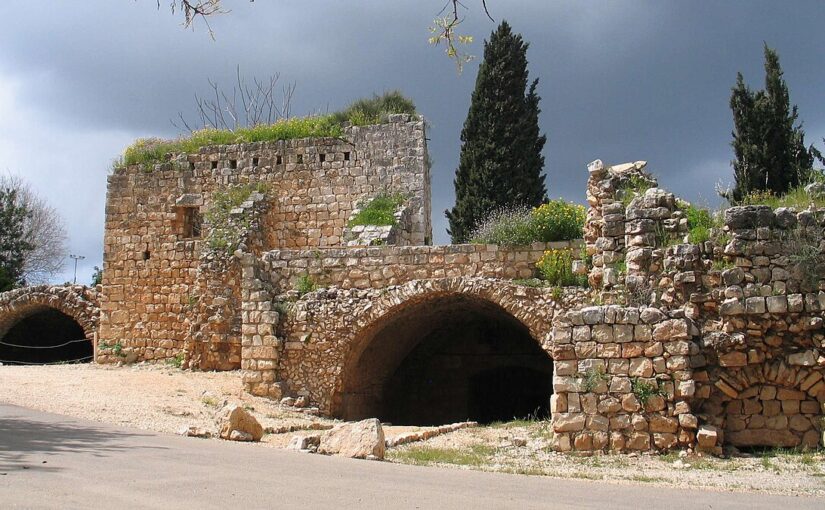Yehiam Fortress sweeps across a hilltop, gazing out over the rolling western Galilee. Clusters of olive trees and swathes of Mediterranean woodland cloak the slopes below, their green set against the blue reach of the sky and distant shimmer of the coastal plain. From the heights of the fortress, the view stretches from Ladder Ridge, across valleys etched deep by ancient streams, all the way to Nahariya, Akko, and even the Carmel mountains. For travelers, the landscape delivers a tranquil sense of space and time. The region is alive with the scents of pine and wildflowers, offering cool breezes during evening hours and radiant golden light as the sun rises.
A Fortress Forged by Crusaders
Built on the sturdy ruins of earlier Roman and Byzantine structures, the site known as Castellum Judin was transformed in the early 13th century. In 1208, Crusader kings granted the strategic ridge to the Teutonic Order, who expanded and strengthened the farmstead into a formidable stone fortress. Its position was the key. Yehiam commands a crossroads in the Galilee, making it both a defensive bulwark and a center for agricultural production. The Teutonic Knights, experts in the art of fortification, built ramparts, towers, and halls that could withstand the uncertainties of the age. Judin soon became a beacon for settlers and a target for rivals.
The Mamluks, led by Sultan Baybars, saw the rising tide of Crusader strength and responded in force. In 1265, his army swept through the Galilee, conquering and partially demolishing the fortress. What remained, broken walls, roofless rooms, skeletal towers, still reflected the endurance and vision of its medieval builders. For centuries, these ruins stood silent as the landscape shifted around them.
From Ruin to Rebirth
Centuries passed, and the fortress found new life under Ottoman rule. In the 18th century, the powerful Bedouin sheikh Daher el-Omar rebuilt parts of Judin, turning its halls and towers into a provincial stronghold. He left an unmistakable mark: ramparts to defend against rivals, granaries to store Galilee’s fragrant harvests, and administrative buildings to oversee his expanding dominion. Daher’s story is written in stone. The Galilee landscape was stitched together by his fortifications, as his territory stretched from Tiberias to Acre and the coastal towns of Haifa and Jaffa. The result is a fortress that holds layers of Crusader and Ottoman craft, still visible today.
The Kibbutz and the War of Independence
Yehiam’s modern story is as dramatic as its ancient one. In 1946, just as the winds of change swept the region, Jewish pioneers founded Kibbutz Yehiam on the site of the ancient fortress. Those first residents, seeking shelter behind stone walls scarred by centuries of sieges, brought new life and purpose to Judin. The legendary story of the War of Independence unfolded here: besieged by Arab forces, the kibbutz members endured attacks, bombardments, and loss, yet ultimately emerged triumphant. Supplies rained down from airplanes, resistance grew fierce, and the old Crusader walls sheltered a new generation fighting for a homeland.
Military and Cultural Significance
From its inception, Yehiam Fortress was a symbol of military might. The Teutonic Knights understood the importance of elevation and stonework in fortification. Their construction strategies gave the fortress an enduring strength, making it one of the largest and most commanding medieval sites in the Galilee. Later, the Ottomans built upon this foundation, adapting it to meet new needs and threats. In every era, the fortress served as a gathering point: for Crusader garrisons, for Bedouin rulers, for settlers defending their communities, and now for visitors drawn by its legends and panoramas.
A Lasting Legacy and a Traveler’s Gem
Yehiam Fortress today is a living testament to the Galilee’s layered history. Declared a national park in 1967, it covers fifty dunams of strategic hilltop and woodland. Visitors wander through Crusader halls and Ottoman chambers, climb towers for panoramic views, and discover positions left from the battles of Israel’s independence. Informative signs guide the curious along walls and terraces that whisper stories in every stone. The park invites picnics, photography, and adventurous hikes along nearby nature reserves, merging education with leisure.
Why visit Yehiam Fortress? The answer comes with every footstep. Here, the sweep of history blends with the serenity of nature. The location’s panoramic views reward those who seek out quiet beauty, while its stones invite questions and reflection. The site is accessible and well preserved, offering a day’s escape for families, hikers, and history enthusiasts alike. Whether learning about Crusaders, pondering the bold vision of Daher el-Omar, or hearing tales of kibbutz founders, every moment spent among these ancient walls connects visitors to the very heart of Galilee’s story.
Yehiam Fortress is much more than a ruin. It is a vantage point over centuries, a resilient landmark, and a tribute to those who built and rebuilt for faith, ambition, and survival. Let its towers and terraces draw you in, and you will depart with a memory as deep and enduring as the Galilee hills themselves.
Image by Bukvoed.
If our work has inspired you, helped you grow, or simply brought a little warmth to your day, consider supporting Thalysia.com with a small donation. Your contribution helps us continue exploring ancient landscapes, documenting local traditions, and celebrating the art of living well.
